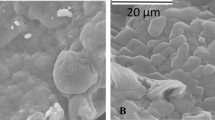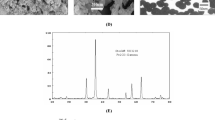Abstract
Atrazine organic pollutant has been found in several water resources of the world. It is highly toxic and carcinogenic in nature. Atrazine is removed by adsorption on iron composite nanoparticles. The composite nanoparticles were synthesized, analyzed and applied for atrazine uptake from water. Residual atrazine was monitored by gas chromatography–mass spectrometry. The maximum atrazine removal (95 %) was achieved using contact time 30.0 min, concentration 30.0 µg/L, pH 7.0, dose 2.5 g/L and temperature 20.0 °C. The adsorbent was selective for atrazine adsorption. The results obeyed Langmuir, Freundlich, Temkin and Dubinin–Radushkevich isotherms. ΔG° values were −6.05, −6.11 and −6.15 kJ/mol at 20, 25 and 30 °C temperatures, respectively. The value of ΔS° was −2.45 × 10−3 kJ/mol K. It showed decline in entropy of atrazine uptake. The adsorption followed pseudo-second-order kinetics. The adsorption mechanism was liquid film diffusion. The proposed adsorption method is inexpensive, fast and reproducible. It can be used to remove atrazine from any water sample/source.






Similar content being viewed by others
References
Ali I (2010) The quest for active carbon adsorbent substitutes: inexpensive adsorbents for toxic metal ions removal from wastewater. Sep Purif Rev 39:95–171
Ali I (2012) New generation adsorbents for water treatment. Chem Rev (ACS) 112:5073–5091
Ali I (2014) Water treatment by adsorption columns: evaluation at ground level. Sep Purif Rev 43:175–2015
Ali I, Aboul-Enein HY (2004) Chiral pollutants: distribution, toxicity and analysis by chromatography and capillary electrophoresis. Wiley, Chichester
Ali I, Gupta VK (2006) Advances in water treatment by adsorption technology. Nat Lond 1:2661–2667
Ali I, Asim M, Khan TA (2012) Low cost adsorbents for removal of organic pollutants from wastewater. J Environ Manage 113:170–183
Atrazine (2007) Chemical Summary, Toxicity and Exposure Assessment for Children’s Health Report. U.S. Environmental Protection Agency, USA
Báez ME, Fuentes E, Espinoza J (2013) Characterization of the atrazine sorption process on andisol and ultisol volcanic ash-derived soils: kinetic parameters and the contribution of humic fractions. J Agric Food Chem 61:6150–6160
Bhattacharyya KG, Sharma A (2005) Kinetics and thermodynamics of methylene blue adsorption on neem leaf powder. Dyes Pigm 65:51–59
Boyd GE, Adamson AW, Myers LS (1947) The exchange adsorption of ions from aqueous solutions by organic zeolites. II: Kinetics. J Am Chem Soc 69:2836–2848
Chaparadza A, Hossenlopp JM (2012) Adsorption kinetics, isotherms and thermodynamics of atrazine removal using a banana peel based sorbent. Water Sci Technol 65:940–947
Chapin RE, Stevens JT, Hughes CL, Kelce WR, Hess RA, Daston GP (1996) Endocrine modulation of reproduction. Fundam Appl Toxicol 29:1–17
Cheung CW, Porter JF, McKay G (2001) Sorption kinetic analysis for the removal of cadmium ions from effluents using bone char. Water Res 35:605–612
Chien SH, Clayton WR (1980) Application of Elovich equation to the kinetics of phosphate release and sorption in soils. Soil Sci Soc Am J 44:265–268
Dean JR, Wade G, Barnabas IJ (1996) Determination of triazine herbicides in environmental samples. J Chromatogr A 733:295–335
Gai K, Shi B, Yan X, Wang D (2011) Effect of dispersion on adsorption of atrazine by aqueous suspensions of fullerenes. Environ Sci Technol 45:5959–5965
Gilliom RJ, Barbash JE, Crawford CG, Hamilton PA, Martin JD, Nakagaki N, Nowell LH, Scott JC, Stackelberg PE, Thelin GP, Wolock DM (2006) US Geological Survey, The Quality of Our Nation’s Waters: Pesticides in the Nation’s Streams and Ground Water, 1992–2001, February 15
Goswami S, Ghosh UC (2005) Studies on adsorption behavior of Cr(VI) onto synthetic hydrous stannic oxide. Water SA 31:57–602
Gupta VK, Yola ML, Eren T, Atar N (2015) Selective QCM sensor based on atrazine imprinted polymer: its application to wastewater sample. Sensors Actuators B: Chem 218:215–221
Ho YS, McKay G (1998) The kinetics of sorption of basic dyes from aqueous solution by sphagnum moss peat. Can J Chem Eng 76:822–827
Hoag GE, Collins JB, Holcomb JL, Hoag JR, Nadagouda MN, Varma RS (2009) Degradation of bromothymol blue by ‘greener’ nano-scale zerovalent iron synthesized using tea polyphenols. J Mater Chem 19:8671–8677
Huang L, Weng X, Chen Z, Megharaj M, Naidu R (2014) Green synthesis of iron nanoparticles by various tea extracts: comparative study of the reactivity. Spectrochim Acta Part A Mol Biomol Spectrosc 130:295–301
Kniewald J, Jakominić M, Tomljenović A, Simić B, Romać P, Vranesić D, Kniewald Z (2000) Disorders of male rat reproductive tract under the influence of atrazine. J Appl Toxicol 20:61–68
Munger R, Isacson P, Hu S, Burns T, Hanson J, Lynch CF, Cherryholmes K, Van Dorpe P, Hausler WJ Jr (1997) Intrauterine growth retardation in Iowa communities with herbicide contaminated drinking water supplies. Environ Health Perspect 105:308–314
Nakamura C, Hasegawa M, Shimada K, Shirai M, Miyake J (2000) Direct triazine herbicide detection using a self-assembled photosynthetic reaction center from purple bacterium. Biotechnol Bioprocess Eng 5:413–417
Nwani CD, Lakra WS, Nagpure NS, Kumar R, Kushwaha B, Srivastava SK (2010) Toxicity of the herbicide atrazine: effects on lipid peroxidation and activities of antioxidant enzymes in the freshwater fish Channa Punctatus (Bloch). Int J Environ Res Pub Health 7:3298–3312
Onyango M, Matsuda H, Ogada T (2003) Sorption kinetics of arsenic onto iron-conditioned zeolite. J Chem Eng Jpn 36:477–485
Phyu YL, Warne MS, Lim RP (2004) Toxicity of atrazine and molinate to the cladoceran Daphnia carinata and the effect of river water and bottom sediment on their bioavailability. Arch Environ Contam Toxicol 46:308–315
Ritter WF (1990) J Environ Sci Health B 25:1–29
Sanagi MM, Muhammad SS, Hussain I, Ibrahim WAW, Ali I (2015) Novel solid-phase membrane tip extraction and gas chromatography with mass spectrometry methods for the rapid analysis of triazine herbicides in real waters. J Sep Sci (in press). doi:10.1002/jssc.201400912
Shahwan T, AbuSirriah S, Nairat M, Boyac E, Eroglu AE, Scott TB, Hallam KR (2011) Green synthesis of iron nanoparticles and their application as a Fenton-like catalyst for the degradation of aqueous cationic and anionic dyes. Chem Eng J 172:258–266
Silva CR, Gomes TF, Andrade GC, Monteiro SH, Dias AC, Zagatto EA, Tornisielo VL (2013) Banana peel as an adsorbent for removing atrazine and ametryne from waters. J Agric Food Chem 61:2358–2363
Southwick LM, Grigg BC, Kornecki TS, Fouss JL (2002) Potential influence of sugarcane cultivation on estuarine water quality of Louisiana’s gulf coast. J Agric Food Chem 50:4393–4399
Stevens JT, Sumner DD (1991) Herbicides. In: Hayes WJ Jr, Laws ER Jr (eds) Handbook of pesticide toxicology. Academic Press, New York
Thorpe N, Shirmohammadi A (2005) Herbicides and nitrates in groundwater of Maryland and childhood cancers: a geographic information systems approach. J Environ Sci Health C Environ Carcinog Ecotoxicol Rev 23:261–278
U.S. ATSDR (2003) Toxicological profile for atrazine, 2003. http://www.atsdr.cdc.gov/toxprofiles/tp153.html
U.S. EPA (2003) Atrazine Interim Reregistration Eligibility Decision, 2003. http://www.epa.gov/oppsrrd1/REDs/atrazine_ired.pdf
Van Leeuwen JA, Waltner-Toews D, Abernathy T, Smit B, Shoukri M (1999) Associations between stomach cancer incidence and drinking water contamination with atrazine and nitrate in Ontario (Canada) agroecosystems, 1987–1991. Int J Epidemiol 28:836–840
Villanueva CM, Durand G, Coutte M, Chevrier C, Cordier S (2005) Atrazine in municipal drinking water and risk of low birth weight, preterm delivery, and small-for-gestational-age status. Occup Environ Med 62:400–405
Watson DG (1999) Pharmaceutical analysis: a text book of pharmacy students and pharmaceutical chemists. Wiley, London
Yoder J, Watson M, Benson WW (1973) Lymphocyte chromosome analysis of agricultural workers during extensive occupational exposure to pesticides. Mutilation Res 21:335–340
Yola ML, Eren T, Atar N (2014) A novel efficient photocatalyst based on TiO2 nanoparticles involved boron enrichment waste for photocatalytic degradation of atrazine. Chem Eng J 250:288–294
Zhang Y, Li Y, Zheng X (2011) Removal of atrazine by nanoscale zero valent iron supported on organobentonite. Sci Total Environ 409:625–630
Zhao X, Ouyang W, Hao F, Lin C, Wang F, Han S, Geng X (2013) Properties comparison of biochars from corn straw with different pretreatment and sorption behaviour of atrazine. Bioresour Technol 147:338–344
Acknowledgments
The authors are thankful to King Saud University, Riyadh, Saudi Arabia, for Visiting Professor Program.
Author information
Authors and Affiliations
Corresponding author
Ethics declarations
Ethical statement
There is no ethical issue related to this manuscript.
Rights and permissions
About this article
Cite this article
Ali, I., ALOthman, Z.A. & Al-Warthan, A. Sorption, kinetics and thermodynamics studies of atrazine herbicide removal from water using iron nano-composite material. Int. J. Environ. Sci. Technol. 13, 733–742 (2016). https://doi.org/10.1007/s13762-015-0919-6
Received:
Revised:
Accepted:
Published:
Issue Date:
DOI: https://doi.org/10.1007/s13762-015-0919-6




